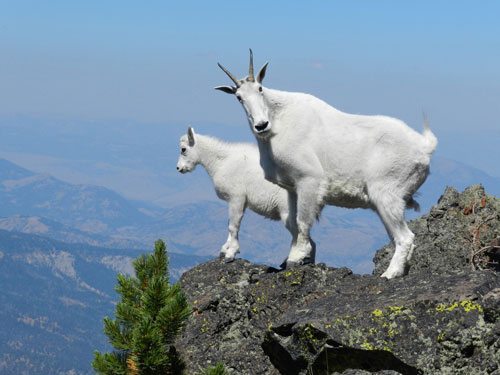
August 24, 2017; Times-Independent (Moab, UT)
The Grand Canyon Trust, along with the Utah Native Plant Society, has appealed the decision by the Utah District Court to dismiss their lawsuit against the U.S. Forest Service. The suit was filed with the expectation that the Forest Service would be forced to permanently remove mountain goats in the La Sal Mountains.
A timeline of the players in the goat saga might be helpful. In 2013, the Utah Division of Wildlife Resources took 20 mountain goats which were not indigenous to Utah, fitted them with tracking collars, and, lifted by slings with helicopters, set them down in the alpine area of the small mountain range known as the La Sal.
The U.S. Forest Service was against the introduction of the goats because of the threat to their prized vegetation. The La Sal is studied by botanists recording climate change data. Several rare plants grow on the terrain, including the La Sal Daisy which is found nowhere else in the world.
The Forest Service lost their argument to the Utah DWR, which would be gaining funds through hunting fees. The goats, now numbering 70, are grazing on the rare plants. Now, the agency that was against the goats from the start is being asked to get them off the mountain. The Forest Service is, naturally, resistant.
DWR regional supervisor Chris Wood stated that mountain goats are a slow-growing species that is a favorite for hunters and wildlife enthusiasts and will not damage the alpine zone.
“We believe that this alpine community in the La Sals evolved with some form of herbivory from deer, from elk, from bighorn sheep, from other species, [and] that introducing mountain goats on the La Sals would not impact the vegetation community on the La Sals.”
“The Forest Service has monitored alpine communities in the Uintah [Mountains] for decades and they have seen zero impact on the vegetation communities from mountain goats. So, we felt very confident that we could introduce mountain goats onto the La Sals and have zero impact on the vegetation community overall,” Wood said.
Wood also said that DWR and the Forest Service have recently signed a vegetation monitoring plan.
Sign up for our free newsletters
Subscribe to NPQ's newsletters to have our top stories delivered directly to your inbox.
By signing up, you agree to our privacy policy and terms of use, and to receive messages from NPQ and our partners.
“Together we’ve come up with a very robust vegetation monitoring plan that will detect any changes in the vegetation that could occur in the next upcoming years and see if there’s any ties to mountain goat use of that area,” Wood said.
The Grand Canyon Trust disagrees, saying it has seen damage. The mission of the trust, an organization that defends 130,000 square miles involving four states, “is to protect and restore the Colorado Plateau—its spectacular landscapes, flowing rivers, clean air, diversity of plants and animals, and areas of beauty and solitude.”
Mary O’Brien, director of the trust’s Utah Forest Program, said, “We’ve started going in this year and [there’s] just a lot of damage.”
Wallows, sensitive plants being eaten. Grasses being uprooted and pulled out while the soil is soft and the roots are now in the air.… This is really, really problematic because the alpine area has a short growing season, between when snow melts and snow comes again.… Alpine areas are already in trouble because of global warming. It’s happening, you can photograph it, you can see it and it’s not supposed to be happening by [the Forest Service’s] own regulations.
The Forest Service was petitioned by the trust and the Utah Native Plant Society in 2015 to remove the goats. The nonprofits believe that, since the Forest Service has not acted, the issue can be litigated in court as a final federal decision. According to the Salt Lake Tribune, however, when the suit was originally dismissed in March, the court found that since the Forest Service had simply refrained from acting, there was no challengeable decision to overturn.
“The chief [of the Forest Service] denied our permit saying…they’re going to monitor, which is beside the point because the rules are [goats] are not supposed to be in the Mount Peale Research Natural Area,” O’Brien said. “So, we have taken both the regional office denying our request that they remove the goats and the chief’s denial as decisions and that’s what we’re litigating on. The court process is very, very slow and the damage is ongoing.”
Forest Service Public Affairs Officer for the Manti-La Sal National Forest Rosann Fillmore could not comment on an active lawsuit.
The 10th Circuit Court of Appeals will hear the case, and the Forest Service is expected to file a response brief by October 10th, said Grand Canyon Trust’s lead attorney, Neil Levine. He further stated that a judge will probably hear arguments in the spring of next year and a final decision could take another six months.
Meanwhile, the goats appear content in their contested digs.—Marian Conway












